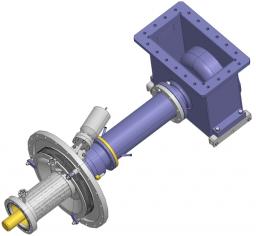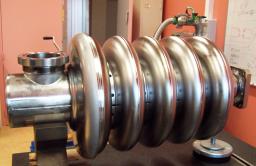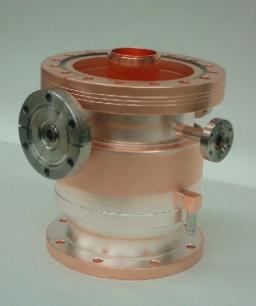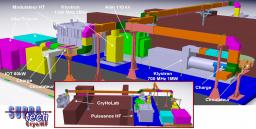As part of the European Care (Coordinated accelerator research in
One of the major themes of this programme is the development of superconducting accelerator structures – particularly efficient for accelerating intense beams with a high-duty cycle – which operate in the 100-200 MeV range and attain gradients above 7 MV/m with quality factors on the order of 1010.
SACM, a major player in this programme, is in charge of building and testing prototypes of superconducting cavities, and of developing and conditioning high-power couplers. It will also install and commission a test station with the horizontal cryostat Cryholab and a radiofrequency power source at 704 MHz with peak output of 1 MW.

Pulsed power coupler (1 MW) for superconducting proton linacs. The main components of the coupler are, from right to left in the diagram, the transition between the waveguide and the coaxial, the window, and the cooled connection to the cavity.
Superconducting cavities at 704 MHz
Several types of superconducting cavities exist; the choice depends on the particle to be accelerated and its energy. In the specific case of 100-200 MeV linacs, the proton velocity β is relativistic (comparable to the speed of light) and varies between 0.4 and 0.6. Elliptical cavities where β equals 0.5 are particularly well-suited to this energy range. However, their operation in pulsed mode can be rather complicated due to electromagnetic pressure forces that act on the walls, thereby modifying the frequency of the cavity. The higher the field level, the more pronounced this phenomenon, which can hinder proper beam acceleration.
In order to overcome this limitation, SACM has designed and built an elliptical superconducting cavity at 704 MHz with the capacity to attain high accelerating fields (after optimisation of surface fields and acceleration efficiency); a double stiffening-ring system makes it possible to control frequency variation at the same time.
Developing 704-MHz power couplers
To accelerate the proton beam (several tens of mA) using high fields (10-20 MV/m), each cavity must be supplied with radiofrequency power on the order of several hundred kilowatts. This is the role of power couplers.
SACM is developing a coupler capable of transmitting up to 1 MW to the cavity in pulsed mode, with an average value of 100 kW. A prototype of the alumina window, which separates the ultra-high vacuum of the cavity from the surrounding air while at the same time allowing for high-frequency matching, has been built. It has undergone testing at low-power levels to verify its high-frequency characteristics. Two complete couplers are currently being built.
Coupler test bench
In order to test all components, SACM will acquire a high-power test bench at 704 MHz supplying more than 1 MW in pulsed mode. The bench includes a 110-kV power supply, a modulator generating 2-ms pulses at 50 Hz, and of course the klystron which generates the radiofrequency power. The klystron output can be connected via a network of waveguides to a test bench and to Cryholab, the test cryostat. This allows for studies on power couplers, for their conditioning, and for conducting cavity tests in an environment comparable to that of an accelerator.
• Accelerator physics and technology › R&D and Instrumentation for Future Accelerators superconducting magnet physics and technology




